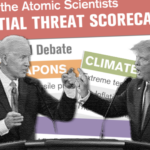A Chinese hypersonic vehicle should come as no surprise
By Marco Fey | January 30, 2014
On January 15, China’s Ministry of National Defense issued a two-sentence press release announcing the successful test of a new strategic delivery system. The so-called “WU-14,” as some have dubbed it, is a hypersonic glide vehicle that supposedly traveled at Mach 10, or about 7,700 mph. If true—the story of the test was broken by the obscure Washington Free Beacon, (“dedicated to uncovering the stories that the professional left hopes will never see the light of day”) and merited only three sentences in the New York Times and a short blurb on Fox News—then the news was shocking. The putative test caused quite some fuss on Capitol Hill, particularly among conservatives, as shown by the following statement by three members of the House Armed Services Committee, Chairman Howard P. “Buck” McKeon (R-CA), Randy Forbes (R-VA), and Mike Rogers (R-AL):
“While round after round of defense cuts have knocked America’s technological advantage on its back, the Chinese and other competitor nations push towards military parity with the United States; in some cases, as in this one, they appear to be leaping ahead of us. This situation does nothing to support peaceful coexistence in the Pacific. … The Asia Pacific is fast becoming a powder keg. Allowing nations that do not share our respect for free and open avenues of commerce to gain a strategic advantage over the United States and her allies only brings us closer to lighting the fuse.”
That China may be interested in developing hypersonic delivery vehicles shouldn’t come as a surprise to anyone. Its two strategic competitors, Russia and India, have their own underway. But it was the US itself that started the race towards Prompt Global Strike capability. Since 2003, the US Air Force, the Defense Advanced Research Projects Agency, and the US Army have worked on developing hypersonic delivery vehicles. Three tests have been conducted so far, at least one of them counting as a success. Hypersonic strike capability comes with a number of strategic implications as its aim is to allow targeting almost every spot on Earth within one hour. The US surprise over China following suit in developing and testing such a system is naïve at best.
The Chinese hypersonic program must be seen in the context of another arms race as well: It is a reaction to US ballistic missile defense plans. Since the 1990s—and reiterated by George W. Bush’s decision to deploy interceptors starting in 2004—China has been concerned over its deterrence capacity. Their small nuclear arsenal of about 250 warheads, with only 40 capable of reaching the US mainland, has Chinese strategists worried that even a rudimentary US missile defense system could negate a second-strike capability against the United States. Hypersonic delivery vehicles would ease such Chinese military concerns. By reaching re-entry speeds simply too fast for current missile defense kill-vehicle technology, they could penetrate the US anti-missile shield.
The reputable, conservative German newspaper Frankfurter Allgemeine Zeitung saw this as the main problem of the Chinese test and explained that “hypersonic weapons are considered to be destabilizing systems because ballistic missile defenses cannot deal with them.”
But the paper got it quite wrong.
It is ballistic missile defense itself that is destabilizing. Granted, hypersonic delivery vehicles do not come without strategic implications themselves, but it is exactly their quality of being able to penetrate missile defenses that could guarantee a certain degree of strategic stability between the US and China in the foreseeable future.
Together, we make the world safer.
The Bulletin elevates expert voices above the noise. But as an independent nonprofit organization, our operations depend on the support of readers like you. Help us continue to deliver quality journalism that holds leaders accountable. Your support of our work at any level is important. In return, we promise our coverage will be understandable, influential, vigilant, solution-oriented, and fair-minded. Together we can make a difference.
Topics: Opinion, Special Topics, Technology and Security














